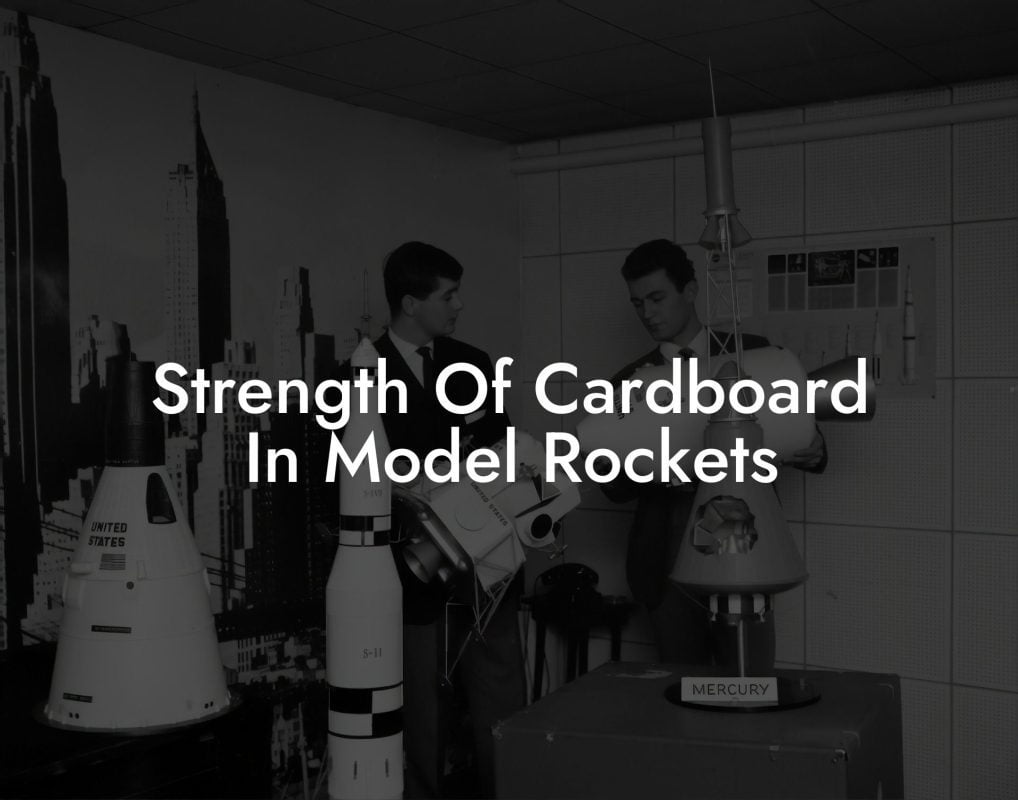Imagine soaring to new heights with your model rockets, but instead of relying on traditional recovery wadding, you're using a substitute that's not only more efficient but also environmentally friendly. Welcome to the world of innovative recovery solutions, where creativity meets functionality and sustainability. Whether you're a seasoned model rocket enthusiast or just starting out, this comprehensive guide will walk you through the best recovery wadding substitutes, their benefits, and how to implement them seamlessly into your model rocketry experience.
Quick Links to Useful Sections
- What is Recovery Wadding, and Why Do We Need a Substitute?
- The Benefits of Recovery Wadding Substitutes
- Top Recovery Wadding Substitutes for Model Rockets
- 1. Newspaper and Glue
- 2. Shredded Paper and Tape
- 3. Biodegradable Packing Peanuts
- 4. Recycled Fabric and Thread
- How to Implement Recovery Wadding Substitutes in Your Model Rockets
- 1. Choose the Right Substitute for Your Rocket
- 2. Prepare the Substitute Material
- 3. Assemble and Test Your Model Rocket
- 4. Monitor and Refine Your Design
- Resources and Community Support: Your Next Steps
- Frequently Asked Questions: Recovery Wadding Substitutes for Model Rockets
What is Recovery Wadding, and Why Do We Need a Substitute?
Recovery wadding is a crucial component in model rocketry, serving as a protective barrier between the parachute and the rocket's payload. However, traditional recovery wadding has its limitations, including environmental concerns, high costs, and limited availability. This is where substitutes come in – offering a more sustainable, cost-effective, and accessible solution for model rocket enthusiasts.
By exploring alternative materials and approaches, we can reduce our environmental footprint, promote innovation, and make model rocketry more inclusive and enjoyable for everyone.
The Benefits of Recovery Wadding Substitutes
So, what makes recovery wadding substitutes so appealing? Here are just a few benefits:
- Environmental Sustainability: Many substitutes are biodegradable, non-toxic, and sourced from renewable resources, reducing the environmental impact of model rocketry.
- Cost-Effectiveness: Substitutes can be more affordable than traditional recovery wadding, making model rocketry more accessible to enthusiasts of all levels.
- Innovation and customization: With a wide range of substitutes available, you can experiment with different materials and designs to optimize your model rocket's performance and recovery.
- Increased Availability: Substitutes can be sourced from local suppliers or even created at home, reducing reliance on specialized manufacturers and ensuring a steady supply.
By embracing recovery wadding substitutes, you're not only contributing to a more sustainable model rocketry community but also opening up new possibilities for creativity and innovation.
Looking For The Best Model Rocket Kits? You'll Love These:
Top Recovery Wadding Substitutes for Model Rockets
So, what are the top recovery wadding substitutes for model rockets? Here are some of the most popular and effective options:
1. Newspaper and Glue
A simple, cost-effective, and eco-friendly substitute, newspaper and glue provide a lightweight, compact solution for model rocket recovery.
2. Shredded Paper and Tape
Another creative substitute, shredded paper and tape offer a flexible, adjustable solution that can be customized to fit your model rocket's specific needs.
3. Biodegradable Packing Peanuts
Made from natural, biodegradable materials, packing peanuts provide a soft, shock-absorbing solution for model rocket recovery.
4. Recycled Fabric and Thread
Upcycle old fabric and thread to create a durable, eco-friendly recovery wadding substitute that's both functional and stylish.
These substitutes offer a range of benefits and can be tailored to suit your specific model rocketry needs and preferences.
How to Implement Recovery Wadding Substitutes in Your Model Rockets
So, how do you incorporate these substitutes into your model rocketry workflow? Here are some tips and best practices:
1. Choose the Right Substitute for Your Rocket
Select a substitute that matches your model rocket's size, weight, and recovery requirements.
2. Prepare the Substitute Material
Follow the specific preparation instructions for your chosen substitute, ensuring it's ready for use in your model rocket.
3. Assemble and Test Your Model Rocket
Assemble your model rocket, incorporating the substitute material, and test it to ensure optimal performance and recovery.
4. Monitor and Refine Your Design
Continuously monitor your model rocket's performance, refining your design and substitute material as needed to achieve the best results.
By following these steps, you can seamlessly integrate recovery wadding substitutes into your model rocketry workflow, enjoying the benefits of sustainability, cost-effectiveness, and innovation.
Resources and Community Support: Your Next Steps
Ready to take your model rocketry to the next level with recovery wadding substitutes? Here are some valuable resources and community support options to help you on your journey:
- Online Forums and Communities: Join online forums and communities dedicated to model rocketry, sharing your experiences and learning from others.
- Tutorials and Guides: Explore tutorials and guides on YouTube, blogs, and websites, offering step-by-step instructions and expert advice.
- Local Model Rocketry Clubs: Connect with local model rocketry clubs, attending meetings and events to network with fellow enthusiasts and learn from their experiences.
- Sustainable Model Rocketry Initiatives: Support initiatives promoting sustainable model rocketry practices, contributing to a more environmentally conscious community.
By tapping into these resources and community support options, you'll stay up-to-date with the latest developments in recovery wadding substitutes and model rocketry, ensuring a fun, innovative, and sustainable experience.
Frequently Asked Questions: Recovery Wadding Substitutes for Model Rockets
Here are some frequently asked questions about recovery wadding substitutes for model rockets:
1. Are recovery wadding substitutes safe for my model rocket?
Yes, when used correctly, recovery wadding substitutes are safe and effective for model rockets.
2. Can I use multiple substitutes in combination?
Yes, you can experiment with combining different substitutes to achieve the best results for your model rocket.
3. How do I ensure the substitute material doesn't interfere with my rocket's electronics?
Take precautions to keep the substitute material away from sensitive electronics, using protective coverings or compartments as needed.
4. Can I reuse recovery wadding substitutes?
Some substitutes can be reused, while others may need to be replaced after each launch. Follow the specific guidelines for your chosen substitute.
5. Are recovery wadding substitutes suitable for all types of model rockets?
While substitutes can be used with various model rockets, some may be more suitable for specific types or sizes. Experiment and find the best substitute for your model rocket.
Looking For The Best Model Rocket Kits? You'll Love These:
Useful Interruption: Dive deeper into the world of Model Rockets with our most popular sections. If there is anything you think is missing or anything you would love for us to write about, just give us a shout.
- Getting Started & Basics With Model Rockets
- Model Rocket Design, Build & Customization
- Model Rocket Propulsion & Engine Technology
- Model Rocket Launch Techniques & Recovery
- Model Rocket Advanced Rocketry & Innovations
- Model Rocket DIY and Customization
- Model Rocket Equipment Reviews & Digital Tools
- Community, Competitions & Education
- Model Rocket Troubleshooting & FAQs
- Model Rocket Bonus/Seasonal & Niche Topics
A group of model rocket enthusiasts gathered at a field for their weekly launch event. Among them was Dave, a seasoned builder known for pushing the limits of hobby rocketry. This time, he had outdone himself.
“Ladies and gentlemen,” Dave announced, dramatically pulling a cloth off his latest creation, “I present to you: The Kraken!”
The crowd gasped. This wasn’t just a model rocket—it was a monster. The thing stood 8 feet tall, had six clustered engines, and was covered in enough duct tape to qualify as a classified aerospace project.
“Dave,” muttered Steve, the cautious safety officer, “Have you, uh… done the math on this?”
“Math?” Dave scoffed. “I built it in my garage at 3 a.m. with parts from eBay. This is an art piece, Steve.”
The countdown began.
5…
4…
3…
2…
1…
The engines ignited with a BOOM, and The Kraken shot up… kind of. It immediately did a violent barrel roll, narrowly missing the spectators before skyrocketing at an angle that could only be described as “legally questionable.”
The crowd collectively ducked as The Kraken flew straight over the adjacent cornfield, where Old Man Jenkins, the grumpiest farmer in town, was minding his business.
KABOOM!
The rocket disappeared behind the barn. A moment later, a flaming piece of Estes igniter wire landed at Steve’s feet. The silence was deafening.
And then—an unmistakable sound echoed across the field.
Jenkins’ shotgun being cocked.
“DAVE!!!” Steve shouted. “RUN.”
And that was the day Dave invented the first-ever biologically powered rocket booster: pure adrenaline.
To this day, nobody knows where The Kraken landed, but legend has it, it still haunts the skies, terrifying unsuspecting drones and low-flying birds.















